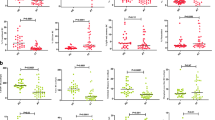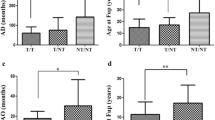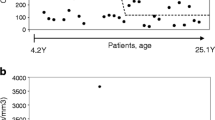Abstract
Several immunological abnormalities have been observed in ataxia-telangiectasia (AT), the most consistent being defects of immunoglobulin isotypes, decreased T-cell numbers, and reduced proliferative responses to mitogens. We examined the distribution of T lymphocytes expressing distinctive surface Ag characteristic of “naive” (CD45RA+) and “memory” (CD29+, CD45RO+) T cells, in both CD4+ and CD8+ (bright and dim) lymphocytes from 13 AT patients, compared with healthy agematched controls. We found that, irrespective of age, patients with AT had a severe deficiency of CD4+/CD45RA+ lymphocytes. This decrease accounted for the reduction of total CD4+ cells, since the absolute numbers ofmemory CD4+ cells were not significantly different in AT and in controls. Functional tests revealed poor proliferative responses to phytohemagglutinin and normal responses to soluble Ag (tetanus toxoid) in AT patients. These data fit with the distribution ofnaive andmemory cells, which are known to respond predominantly to mitogens or to recall Ag, respectively. CD45RA molecules were normally expressed on CD8+ lymphocytes. This rules out a generalized defect of regulation or differential splicing as the cause of defective expression of CD45RA on CD4+ cells. The selective deficiency of CD4+CD45RA+ may provide a cellular basis for some functional T-cell abnormalities of AT patients. Furthermore, it might practically serve for an early, or even prenatal, diagnosis of this disease.
Similar content being viewed by others
References
Bridges BA, Harnden DG (eds):Ataxia-Telangiectasia: A Cellular and Molecular Link Between Cancer, Neuropathology and Immune Deficiency. Chichester, J. Wiley & Sons, 1982
Gatti RA, Swift M (eds):Ataxia-Telangiectasia: Genetics, Neuropathology and Immunology of a Degenerative Disease of Childhood. New York, Alan R. Liss, 1985
Oxelius VA, Berkel AI, Hanson LA: IgG2 deficiency in ataxia-telangiectasia. N Engl J Med 306:515–517, 1982
Waldmann TA, Broder S, Goldman CK, Frost K, Korsmeyer SJ, Medici MA: Disorders of B cells and helper T cells in the pathogenesis of the immunoglobulin deficiency of patients with ataxia-telangiectasia. J Clin Invest 71:282–295, 1983
Fiorilli M, Businco L, Pandolfi F, Paganelli R, Russo G, Aiuti F: Heterogeneity of immunological abnormalities in ataxia-telangiectasia. J Clin Immunol 3:135–141, 1983
Fiorilli M, Carbonari M, Crescenzi M, Russo G, Aiuti F: T cell receptor genes and ataxia-telangiectasia. Nature 313:186, 1985
Gatti RA, Aurias A, Griscelli C, Sparkes RS: Translocations involving chromosomes 2p and 22q in ataxia-telangiectasia. Dis Markers 3:169–175, 1985
Fulop GM, Phillips RA: The SCID mutation in the mice causes a general defect in DNA repair. Nature 347:479–482, 1990
Rudd CE, Morimoto C, Wong LI, Schlossman SF: The subdivision of the T4 (CD4) subset on the basis of the differential expression of LCA/T200 antigens. J Exp Med 166:1758–1773, 1987
Thomas ML, Lefrancois L: Differential expression of the leucocyte-common antigen family. Immunol Today 9:320–326, 1988
Streull M, Hall LR, Saga Y, Schlossman SF, Saito H: Differential usage of three exons generates at least five different mRNAs encoding human leukocite common antigens. J Exp Med 166:1548–1566, 1987
Sanders ME, Makgoba MW, Sharrow SO, Stephany D, Springer TA, Young HA, Shaw S: Human Memory T lymphocytes express increased levels of three cell adhesion molecules (LFA-3, CD2, and LFA-1) and three other molecules (UCHL-1, CDw29, and Pgp-1) and have enhanced IFN-gamma production. J Immunol 140:1401–1407, 1988
Springer TA: Adhesion receptors of the immune system. Nature 348:425–434, 1990
Morimoto C, Letvin NL, Boyd AW, Hagan M, Brown HM, Kornacki MM, Schlossman SF: The isolation and characterization of the human helper inducer T cell subset. J Immunol 134:3762–3769, 1985
Smith SH, Brown MH, Rowe D, Callard RE, Beverley CL: Functional subsets of human helper-inducer cells defined by a new monoclonal antibody, UCHL-1. Immunology 58:63–70, 1986
Morimoto C, Letvin NL, Distaso JA, Aldrich WA, Schlossman SF: The isolation and characterization of the human suppressor inducer T cell subset. J Immunol 134:1508–1515, 1985
Sanders ME, Malegapuru W, Makgoba, Shaw S: Humannaive andmemory T cells, reinterpretation of helper-inducer and suppressor-inducer subsets. Immunol Today 9(7–8):195–199, 1988
Akbar AN, Terry L, Timms A, Beverley PCL, Jannossy G: Loss of CD45 and gain of UCHL1 reactivity is a feature of primed T cells. J Immunol 140:2171–2178, 1988
Dohlsten M, Hedlund G, Sjögren, Carlsson R: Two subset of human CD4+ T helper cells differing in kinetics and capacities to produce interleukin 2 and interferon-gamma can be defined by the Leu-18 and UCHL-1 monoclonal antibodies. Eur J Immunol 18:1173–1178, 1988
Carbonari M, Cherchi M, Paganelli R, Giannini G, Galli E, Gaetano C, Papetti C, Fiorilli M: Relative increase of T cells expressing the γ/δ rather than the α/β receptor in ataxiatelangiectasia. N Engl J Med 322:73–76, 1990
McFarlin DD, Strober W, Waldmann TA: Ataxiatelangiectasia. Medicine 51:281–314, 1972
Paganelli R, Capobianchi MR, Matricardi PM, Cioè L, Seminara R, Dianzani F, Aiuti F: Defective interferon gamma production in ataxia-telangiectasia. Clin Immunol Immunopathol 32:387–391, 1984
Byrne JA, Butler JL, Cooper MD: Differential activation requirement forvirgin andmemory T cells. J Immunol 141:3249–3257, 1988
De Paoli P, Battistin S, Santini GF: Age-related changes in human lymphocyte subsets: Progressive reduction of the CD4 CD45R (suppressor inducer) population. Clin Immunol Immunopathol 48:290–294, 1988
Landersberg R, Fallon M, Insel R: Alterations in helper-inducer and suppressor-inducer T-cell subsets in human neonatal blood. Immunology 65:323–327, 1988
Hayward AR, Lee J, Beverley PC: Ontogeny of expression of UCHL-1 antigen on TcR-1+ (CD4/8) and TcRδ+ T cells. Eur J Immunol 19:771–775, 1989
Bradley LM, Bradley JS, Ching DL, Shiigi SM: Predominance of T cells that express CD45R in the CD4+ helper inducer lymphocyte subset of neonates. Clin Immunol Immunopathol 51:426–435, 1989
Pilarski LM, Gillitzer R, Zola H, Shortman K, Scollay R: Definition of the thymic generative lineage by selective expression of high molecular weight isoforms of CD45 (T200). Eur J Immunol 19:589–597, 1989
Serra HM, Ledbetter JA, Krowka JF, Pilarski LM: Loss of CD45R (Lp220) represents a post-thymic T cell differentiation event. J Immunol 140:1435–1441, 1988
Budd RC, Cerottini JC, Horvath C, Bron C, Pedrazzini T, Howe RC, McDonald HR: Distinction of virgin and memory T cells. Stable acquisition of the PgP-1 glycoprotein concomitant with antigenic stimulation. J Immunol 138:3120–3129, 1987
Waldmann TA: Immunological abnormalities in ataxiatelangiectasia.In Ataxia-Telangiectasia, BA Bridges, DG Harnden (eds). Chichester, John Wiley & Sons, 1982, pp 37–51
Bell EB, Sparshott SM: Interconversion of CD45R subsets of CD4 T cells in vivo. Nature 348:163–166, 1990
Sobel RA, Hafler DA, Castro EE, Morimoto C, Weiner HL: The 2H4 (CD45R) antigen is selectively decreased in multiple sclerosis lesions. J Immunol 140:2210–2214, 1988
Koch AE, Robinson PG, Radosevich JA, Pope RM: Distribution of CD45RA and CD45R0 T lymphocyte subset in rheumatoid arthritis synovial tissue. J Clin Immunol 10:192–196, 1990
Serra HM, Mant MJ, Ruether BA, Ledbetter JA, Pilarski LM: Selective loss of CD4+ CD45R+ T cells in peripheral blood of multiple myeloma patients. J Clin Immunol 8:259–265, 1988
Lebranchu Y, Thibault G, Degenne D, Bardos P: Deficiency of CD4+CD45R+ T lymphocytes in common variable immunodeficiency. N Engl J Med 323:276–277, 1990 (letter)
Reinherz EL, Cooper MD, Schlossman SF, Rosen FS: Abnormalities of T cell maturation and regulation in human beings with immunodeficiency disorders. J Clin Invest 68:699–705, 1981
Author information
Authors and Affiliations
Rights and permissions
About this article
Cite this article
Paganelli, R., Scala, E., Scarselli, E. et al. Selective deficiency of CD4+/CD45RA+ lymphocytes in patients with ataxia-telangiectasia. J Clin Immunol 12, 84–91 (1992). https://doi.org/10.1007/BF00918137
Accepted:
Issue Date:
DOI: https://doi.org/10.1007/BF00918137




